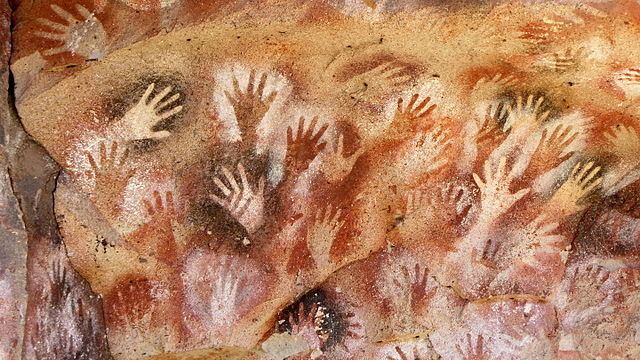Cueva de las Manos
The Cueva de las Manos (Cave of the Hands), nestled in the remote canyon of the Pinturas River in the province of Santa Cruz, Argentina, is one of the most extraordinary prehistoric art sites in the Americas. Famous for its vivid stenciled handprints and dynamic hunting scenes, the cave art dates from approximately 13,000 to 9,000 years ago, offering an unparalleled visual narrative of the early hunter-gatherer societies of South America.
Roger Swidorowicz
5/26/20253 min read


Cueva de las Manos – Argentina: A Testament of Ancestral Identity and Artistic Innovation
Introduction
The Cueva de las Manos (Cave of the Hands), nestled in the remote canyon of the Pinturas River in the province of Santa Cruz, Argentina, is one of the most extraordinary prehistoric art sites in the Americas. Famous for its vivid stenciled handprints and dynamic hunting scenes, the cave art dates from approximately 13,000 to 9,000 years ago, offering an unparalleled visual narrative of the early hunter-gatherer societies of South America.
Recognized as a UNESCO World Heritage Site since 1999, the site is a unique cultural and archaeological landmark. It reflects a sophisticated symbolic tradition and a deep connection to landscape, identity, and social cohesion. The striking imagery—particularly the hundreds of negative handprints that give the site its name—continues to intrigue archaeologists, historians, and artists worldwide.
Geographical and Archaeological Context
The cave is located in the Patagonian steppe, within a dramatic basaltic canyon that provided natural shelter and strategic advantages for prehistoric peoples. The harsh environment, marked by arid plains and cold temperatures, required both adaptation and ingenuity.
Excavations at the site have revealed rich archaeological layers, including tools, pigments, animal bones, and hearths. These findings demonstrate long-term occupation by nomadic groups, likely ancestors of the Tehuelche people. The site's stratigraphy has helped archaeologists reconstruct millennia of human activity in the region.
The Iconic Hand Stencils
The defining feature of Cueva de las Manos is the collection of over 800 hand stencils, most of which are left hands. These negative impressions were created by placing a hand on the rock surface and blowing pigment around it, likely using bone tubes as airbrushes.
Symbolism and Function
Interpretations of the handprints vary:
Identity markers: Some researchers believe they may have denoted clan or individual presence.
Ritualistic or initiatory roles: The repetitive and concentrated placement suggests a ceremonial use, possibly linked to rites of passage or spiritual beliefs.
Communication and memory: Others see them as a way to mark territory or convey social messages.
The predominance of left-hand prints suggests that most individuals held the airbrush tool with their dominant right hand, offering subtle anthropological insights.
Depictions of Fauna and Daily Life
Beyond the handprints, the cave walls depict vivid hunting scenes, particularly involving guanacos, a native South American camelid crucial to survival in the region. The animals are shown in dynamic poses, often surrounded by human figures wielding boleadoras (traditional throwing weapons).
These portrayals provide direct evidence of subsistence strategies and group coordination. Other animals include rheas, felines, and abstract representations possibly linked to mythological figures or shamanic visions.
Artistic Techniques and Pigments
Artists at Cueva de las Manos used mineral-based pigments including:
Iron oxides for red and ochre tones
Manganese for black
Kaolin for white
These were mixed with binders like animal fat or blood and applied using airbrush methods, brushes, or fingers. Engravings were also present but are less prominent.
Techniques varied from flat silhouettes to detailed contouring and superimposition, revealing an evolving artistic tradition over thousands of years. The use of natural rock relief further enhanced the dimensionality and expression of the figures.
Chronology and Occupation Phases
Radiocarbon dating places the earliest art at around 13,000 years BP (Before Present), with successive phases continuing until approximately 7,000 years BP. Each phase reflects:
Changes in stylistic representation
Different pigment compositions
Shifts in social or environmental contexts
This continuity suggests that the cave was a sacred or communal space, revisited over generations, where knowledge, memory, and identity were transmitted through images.
Interpretations and Cultural Significance
The cave’s iconography is often interpreted through the lens of:
Shamanism: Suggesting trance states or communication with spiritual entities
Mythology: Possibly representing origin myths or ancestral narratives
Social organization: Reflected in coordinated hunting and communal rituals
What makes Cueva de las Manos particularly compelling is the integration of landscape, survival, and symbolism. The surrounding canyon may have been considered a liminal or sacred space, echoing with ancestral presence and memory.
UNESCO World Heritage and Conservation Efforts
In 1999, UNESCO inscribed Cueva de las Manos on the World Heritage List, praising its exceptional testimony to prehistoric human life and its extraordinary artistic achievements.
Due to increasing tourism and natural erosion, significant efforts have been made to protect the site, including:
Controlled access to minimize human impact
Installation of viewing platforms
Ongoing conservation and digital documentation
Researchers are also creating high-resolution 3D models and virtual tours to democratize access and support preservation.
Influence on Modern Culture and Scholarship
Cueva de las Manos has influenced:
Anthropological studies on early symbolic behavior
South American identity and heritage movements
Art and literature, becoming a recurring motif in Argentine visual culture
Its images have been reproduced in museums, schoolbooks, and national narratives as symbols of endurance, creativity, and the primal human need for expression.
Cueva de las Manos is more than a prehistoric art gallery; it is a monument to human resilience, identity, and creativity. The haunting presence of hands reaching across millennia invites contemplation of our shared ancestry and the enduring power of symbolic thought.
Whether interpreted as spiritual testimony, social chronicle, or aesthetic achievement, the cave remains a sacred archive of early humanity. It reminds us that long before written words, humans etched their stories into stone—with purpose, reverence, and a desire to be remembered.
As scientific research continues and preservation efforts advance, Cueva de las Manos will endure as a beacon of our collective past—a place where the silent hands of history still speak.
